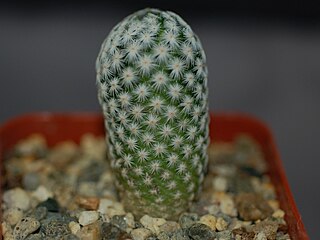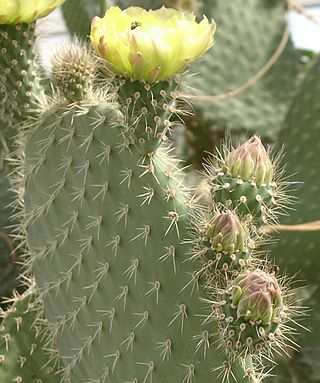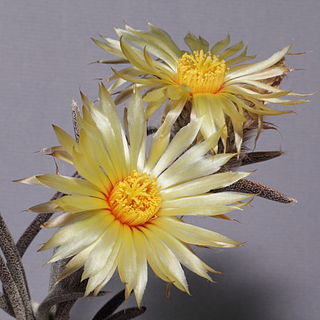
Echinocactus grusonii or Kroenleinia grusonii, popularly known as the golden barrel cactus, golden ball or mother-in-law's cushion, is a species of barrel cactus which is endemic to east-central Mexico.

Astrophytum ornatum, the bishop's cap or monk's hood cactus, is a flowering plant of the family Cactaceae, endemic to the Central Plateau of Mexico. It is the largest and tallest species of Astrophytum.

Ariocarpus agavoides is a species of cactus. It is endemic to Mexico. It grows in dry shrubland in rocky calcareous substrates.

Ariocarpus scaphirostris is a species of plant in the family Cactaceae. The Ariocarpus scaphirostris was originally called Ariocarpus scapharostrus in the 1930. D. R. Hunt, however, changed it to Ariocarpus scaphirostris.

Lophophora diffusa, commonly known as false peyote, is a species of plant in the family Cactaceae and one of the only two species in the Lophophora genus. It is endemic to Mexico in the outskirts of Querétaro. This species contains zero to trace amounts of mescaline; pellotine, whose psychoactive effects are comparatively minimal, is the principal alkaloid. The species name diffusa refers to the flat tubercles that are outspread without the plant having prominent ribs.

Mammillaria herrerae is a species of plant in the family Cactaceae. It is endemic to Mexico where it is confined to Querétaro. Its habitat is semi-desert shrubland. It is threatened by habitat loss and illegal collection. In a 20-year period over 95% of the species population was illegally collected or sold. Mammillaria herrerae has an IUCN rating of critically endangered.

Thelocactus hastifer is a species of plant in the family Cactaceae. It is endemic to Mexico. Its natural habitat is hot deserts.

Kadenicarpus pseudomacrochele, synonym Turbinicarpus pseudomacrochele, is a species of plant in the family Cactaceae.

Opuntia leucotricha is a species of cactus with the common names: arborescent pricklypear, Aaron's beard cactus, and semaphore cactus; and duraznillo blanco and nopal blanco.

Opuntia robusta, the wheel cactus, nopal tapon, or camuesa, is a species of cactus in the family Cactaceae. It is native and endemic to central and northern Mexico to within 100 miles (160 km) of the Arizona and New Mexico borders where it grow from 5,000 to 10,000 feet on rocky slopes, open shrub lands, woodlands and mixed with other cactus and succulents.

Mammillaria longimamma is a species of cactus from Hidalgo and Querétaro, Mexico.

Opuntia macrocentra, the long-spined purplish prickly pear or purple pricklypear, is a cactus found in the lower Southwestern United States and Northwestern Mexico. A member of the prickly pear genus, this species of Opuntia is most notable as one of a few cacti that produce a purple pigmentation in the stem. Other common names for this plant include black-spined pricklypear, long-spine prickly pear, purple pricklypear, and redeye prickly pear.

Thelocactus setispinus, known commonly as miniature barrel cactus or hedgehog cactus, is a cactus in the genus Thelocactus of the family Cactaceae.

Mammillaria magnimamma, common name Mexican pincushion, is a species of flowering plant in the cactus family Cactaceae.

Mammillaria geminispina, the twin spined cactus, is a species of flowering plant in the family Cactaceae, native to central Mexico. It grows to 25 cm (10 in) tall by 50 cm (20 in) broad. The clustering spherical stems, 8 cm in diameter, are covered in white down and white spines. Carmine pink flowers are borne in summer and autumn.

Mammillaria hahniana, the old lady cactus, is a species of flowering plant in the family Cactaceae, native to central Mexico. It grows to 25 cm (10 in) tall by 50 cm (20 in) broad. The solitary spherical stems, 12 cm in diameter, are covered in white down and white spines. Reddish purple flowers are borne in spring and summer, sometimes forming a complete ring around the apex of the plant.

Mammillaria bocasana is a species of cactus in the subfamily Cactoideae. It is often sold as a "powder puff" cactus, and also as a "Powder Puff Pincushion." The plant is protected from collecting in the wild in Mexico.

Astrophytum caput-medusae is a species of cactus native to Mexico, specifically the state of Nuevo León; the plant is reported to grow wild only at a single location. This species differs from the conventional star-shaped phenotype associated with other Astrophytum members. The plant is characterized by a cylindrical, reduced stem with triangular or cylindrical tubercles producing yellow flowers with orange perianth sections. Propagation by seed, tissue culture or via grafting have all been reported. The species is considered critically endangered by the IUCN due to the plant's limited growth range, destruction by livestock and over collection of wild specimen by plant collectors

Thelocactus leucacanthus is a species of cactus. It is endemic to Mexico.

Mammillaria uncinata is a species of cactus in the family Cactaceae. It is endemic to Mexico.


























